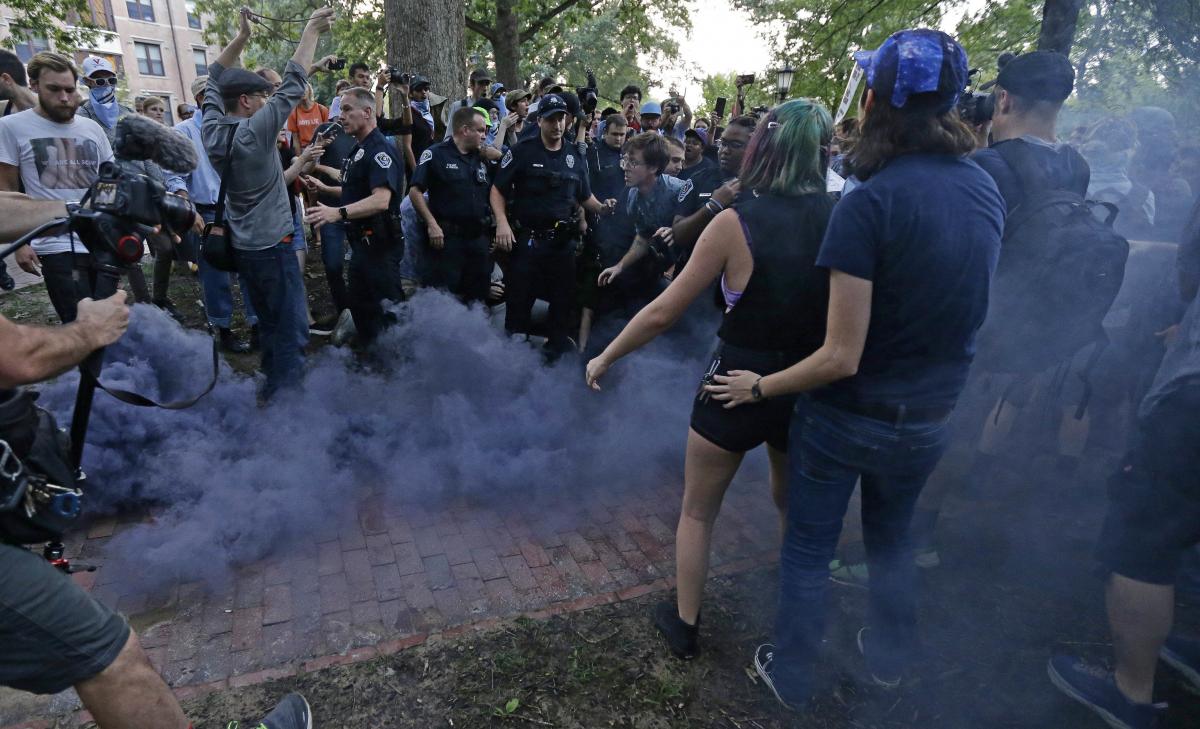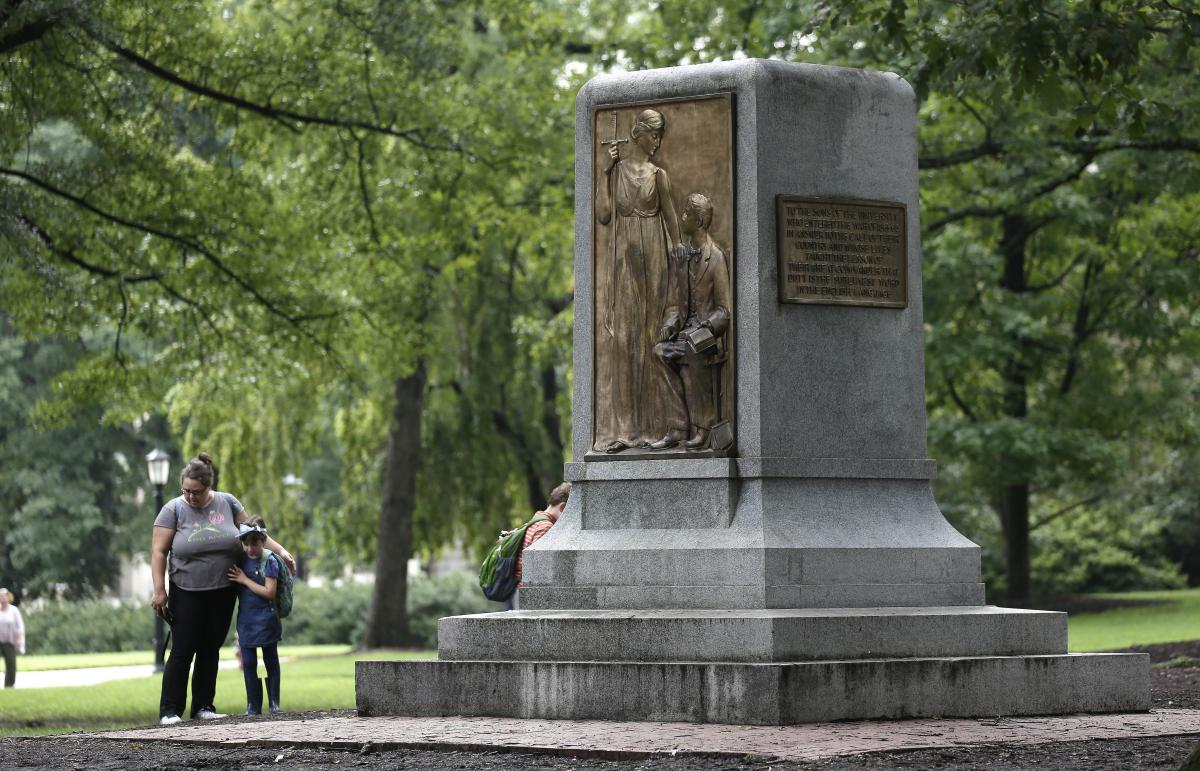Leaders of North Carolina's university system spoke out Tuesday to condemn the toppling of a century-old Confederate memorial on the state's flagship campus by protesters who decried racist motives for its placement on campus dating to a dedication speech praising violence against former slaves.
The University of North Carolina system's president and the chairman of the Board of Governors promised a full criminal investigation of the Monday night protest that brought down the statue known as "Silent Sam." The bronze figure of an anonymous rebel soldier was pulled down from its tall stone pedestal by protesters using ropes and banners to mask their action.
"The safety and security of our students, faculty, and staff is paramount," President Margaret Spellings and board chairman Harry Smith said in a statement Tuesday. "And the actions last evening were unacceptable, dangerous, and incomprehensible. We are a nation of laws and mob rule and the intentional destruction of public property will not be tolerated."
The statue, erected by the United Daughters of the Confederacy in 1913, had been under constant police surveillance after being vandalized in recent months, costing the university hundreds of thousands of dollars.

Protesters appeared to outwit officers with coordinated tactics that started with the raising of four tall black banners on bamboo poles, along with more banners on the ground, concealing efforts to tie a rope around it. They then split into two groups, with most marching away from the statue to distract from a small group remaining behind. The banners were up for about an hour before the groups converged and yanked the statue down, according to videos.
Silent Sam's century-long presence in the center of a main quadrangle ended around midnight after workers covered it with a tarp, lifted it with a backhoe and put it into the back of a truck for a trip to an undisclosed storage location.
Campus police say one person faces criminal charges for his role in the event.
Police at the Chapel Hill campus said Tuesday they charged a 27-year-old man for resisting or obstructing an officer and for wearing a hood or mask on public property.
Ian Broadhead of rural Watauga County did not have a listed phone number and The Associated Press was unable to reach him for comment Tuesday.
UNC-Chapel Hill police spokesman Randy Young said Broadhead is not a student at the school.
Maya Little, who is charged with vandalism for her protest in April, said Tuesday that UNC-Chapel Hill had more than 100 years to remove the statue known as "Silent Sam" and didn't do it, so others took it down Monday night.
She says the toppling exemplifies activists' commitment to "smashing white supremacy" at UNC.
House Speaker Tim Moore also criticized the protesters, saying they should be arrested and prosecuted "to make clear that mob rule and acts of violence will not be tolerated in our state."
Their statements were stronger than that of Chancellor Carol Folt, who didn't call for arrests and charges in her comment Monday night.
Instead, she described the protesters' actions as unlawful and dangerous, while acknowledging that the "monument has been divisive for years, and its presence has been a source of frustration for many people."
Once the statue fell, "Silent Sam's" face down in the dirt, demonstrators kicked it and cheered, chanting "Tar Heels!" and "Whose Campus? Our Campus!" as passing cars honked in approval.

Many students, faculty and alumni argued that "Silent Sam" symbolized racism and asked officials to take it down. Protesters responded to the assertion that the statue wasn't a symbol of white power by reading from its 1913 dedication speech, by tobacco magnate Julian Carr, which praises Confederate veterans for terrorizing former slaves and making sure "the purest strain of the Anglo Saxon is to be found in the 13 Southern States."
Two friends who have protested against "Silent Sam" for years, C.J. Suitte and Will McInerney, said Tuesday they wonder if UNC will return the statue to its still-standing pedestal.
"People have been protesting the statues since the 50s and 60s and it always finds a way to come back. People find a way to defend it," said Suitte, a Chapel Hill resident. "It feels a little surreal. I feel excited but I also feel like — alright, how long is it going to be before they bring the crane in and put him back?"
North Carolina ranks among the handful of Southern states with the most Confederate monuments, and has been a focal point in the national debate over them following a deadly white nationalist protest a year ago in Charlottesville, Virginia.
Protests over the UNC statue flared in the past year, and another Confederate monument in nearby Durham was torn down by protesters shortly after the Virginia rally.
Gov. Roy Cooper had called for removing "Silent Sam" and other rebel symbols on public land. A state historic panel is set to meet Wednesday to debate Cooper's request to remove other Confederate monuments at the state Capitol.
Still, the Democratic governor issued a statement on Twitter on Monday night arguing the protesters took the wrong approach.
"The Governor understands that many people are frustrated by the pace of change and he shares their frustration, but violent destruction of public property has no place in our communities," said the tweet from his official account.
Campus police referred questions to the university's media relations department, which declined to answer questions Tuesday.
300x250 Ad
300x250 Ad
